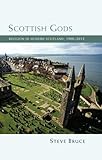Scottish Gods : Religion in Modern Scotland 1900-2012 / Steve Bruce.
Material type: TextPublisher: Edinburgh : Edinburgh University Press, [2022]Copyright date: ©2014Description: 1 online resource (256 p.)Content type:
TextPublisher: Edinburgh : Edinburgh University Press, [2022]Copyright date: ©2014Description: 1 online resource (256 p.)Content type: - 9780748682898
- 9780748682904
- 200.94110904 23
- online - DeGruyter
- Issued also in print.
| Item type | Current library | Call number | URL | Status | Notes | Barcode | |
|---|---|---|---|---|---|---|---|
 eBook
eBook
|
Biblioteca "Angelicum" Pont. Univ. S.Tommaso d'Aquino Nuvola online | online - DeGruyter (Browse shelf(Opens below)) | Online access | Not for loan (Accesso limitato) | Accesso per gli utenti autorizzati / Access for authorized users | (dgr)9780748682904 |
Browsing Biblioteca "Angelicum" Pont. Univ. S.Tommaso d'Aquino shelves, Shelving location: Nuvola online Close shelf browser (Hides shelf browser)

|

|

|

|

|

|

|
||
| online - DeGruyter Contemporary Stylistics : Language, Cognition, Interpretation / | online - DeGruyter Translation as Collaboration : Virginia Woolf, Katherine Mansfield and S.S. Koteliansky / | online - DeGruyter Crisis and the US Avant-Garde : Poetry and Real Politics / | online - DeGruyter Scottish Gods : Religion in Modern Scotland 1900-2012 / | online - DeGruyter The Post-Political and Its Discontents : Spaces of Depoliticisation, Spectres of Radical Politics / | online - DeGruyter Nineteenth-Century U.S. Literature in Middle Eastern Languages / | online - DeGruyter The Animal Question in Deconstruction / |
restricted access online access with authorization star
http://purl.org/coar/access_right/c_16ec
How much has Scotland's religious landscape changed in the last century, and why? GBS_insertPreviewButtonPopup(['ISBN:9780748682898']);Steve Bruce here presents a highly readable account of the changing nature and place of religion in Scotland in an increasingly irreligious society. In 1900 Scotland was a largely Presbyterian country and the Christian churches were a major social force. Now less than 10 per cent of Scots attend church. As religion has declined, it has become more varied: Catholicism has grown as have Charismatic Christian fellowships; Buddhist and Hindu themes have 'easternised' our religious vocabulary; a significant Muslim population has become established; and a notable number of Scots now pursue personal spiritual interests in forms which would once have been dismissed as pagan. Both this decline and the diversification deserve explanation. The Protestant-Catholic divide has faded but Scots have new controversies over the proper public place of religion in the light of growing secularization and diversification. The growth of individual liberty and increasing cultural diversity combine to weaken all shared beliefs by changing religion from a social matter into a private personal concern. All religious groups are faced with the choice of either accommodating that trend and losing their distinctiveness or resisting it and making membership too costly for most potential adherents. This radical remapping of Scotland's religious character is a fascinating summary of a remarkable career of research and analysis by one of our leading social historians. Topics include: Lewis, Orkney and Shetland compared; the integration of the Irish; the growth and decline of the Catholic Church; Scotland Orange and Protestant; the Post-War Kirk; factionalism in the conservative Presbyterian churches; the failure of the charismatic movement in Scotland; Samye Ling and Buddhism; Findhorn and New Age spirituality; Scots Muslims; and arguments over the ordination of women and gay rights. Key FeaturesA rare overarching analysis of religion in Scotland in the 20th centuryA highly readable account of the changing nature and place of religion in a society which places less and less importance on religionNon-partisan in perspectiveInformed by substantial statistical evidenceThe author is one of Scotland's leading social scientists"
Issued also in print.
Mode of access: Internet via World Wide Web.
In English.
Description based on online resource; title from PDF title page (publisher's Web site, viewed 24. Mai 2022)


